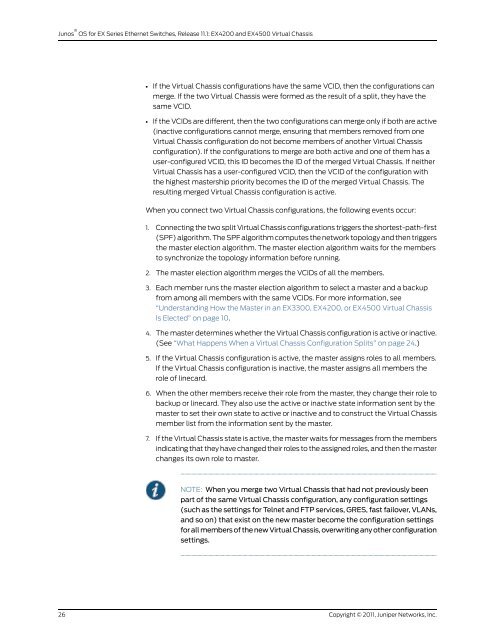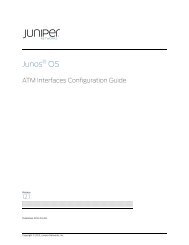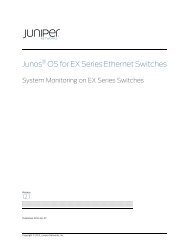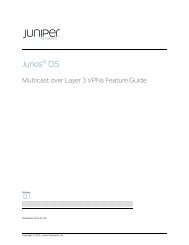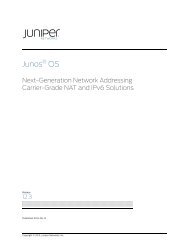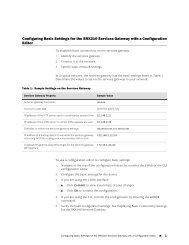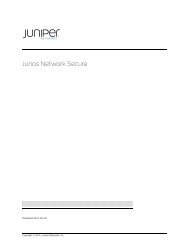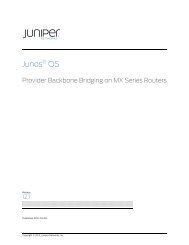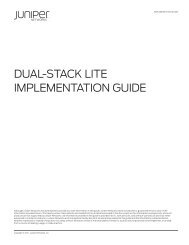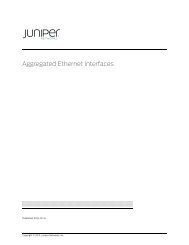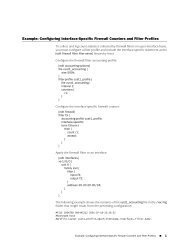Junos® OS for EX Series Ethernet Switches ... - Juniper Networks
Junos® OS for EX Series Ethernet Switches ... - Juniper Networks
Junos® OS for EX Series Ethernet Switches ... - Juniper Networks
You also want an ePaper? Increase the reach of your titles
YUMPU automatically turns print PDFs into web optimized ePapers that Google loves.
Junos ® <strong>OS</strong> <strong>for</strong> <strong>EX</strong> <strong>Series</strong> <strong>Ethernet</strong> <strong>Switches</strong>, Release 11.1: <strong>EX</strong>4200 and <strong>EX</strong>4500 Virtual Chassis• If the Virtual Chassis configurations have the same VCID, then the configurations canmerge. If the two Virtual Chassis were <strong>for</strong>med as the result of a split, they have thesame VCID.• If the VCIDs are different, then the two configurations can merge only if both are active(inactive configurations cannot merge, ensuring that members removed from oneVirtual Chassis configuration do not become members of another Virtual Chassisconfiguration). If the configurations to merge are both active and one of them has auser-configured VCID, this ID becomes the ID of the merged Virtual Chassis. If neitherVirtual Chassis has a user-configured VCID, then the VCID of the configuration withthe highest mastership priority becomes the ID of the merged Virtual Chassis. Theresulting merged Virtual Chassis configuration is active.When you connect two Virtual Chassis configurations, the following events occur:1. Connecting the two split Virtual Chassis configurations triggers the shortest-path-first(SPF) algorithm. The SPF algorithm computes the network topology and then triggersthe master election algorithm. The master election algorithm waits <strong>for</strong> the membersto synchronize the topology in<strong>for</strong>mation be<strong>for</strong>e running.2. The master election algorithm merges the VCIDs of all the members.3. Each member runs the master election algorithm to select a master and a backupfrom among all members with the same VCIDs. For more in<strong>for</strong>mation, see“Understanding How the Master in an <strong>EX</strong>3300, <strong>EX</strong>4200, or <strong>EX</strong>4500 Virtual ChassisIs Elected” on page 10.4. The master determines whether the Virtual Chassis configuration is active or inactive.(See “What Happens When a Virtual Chassis Configuration Splits” on page 24.)5. If the Virtual Chassis configuration is active, the master assigns roles to all members.If the Virtual Chassis configuration is inactive, the master assigns all members therole of linecard.6. When the other members receive their role from the master, they change their role tobackup or linecard. They also use the active or inactive state in<strong>for</strong>mation sent by themaster to set their own state to active or inactive and to construct the Virtual Chassismember list from the in<strong>for</strong>mation sent by the master.7. If the Virtual Chassis state is active, the master waits <strong>for</strong> messages from the membersindicating that they have changed their roles to the assigned roles, and then the masterchanges its own role to master.NOTE: When you merge two Virtual Chassis that had not previously beenpart of the same Virtual Chassis configuration, any configuration settings(such as the settings <strong>for</strong> Telnet and FTP services, GRES, fast failover, VLANs,and so on) that exist on the new master become the configuration settings<strong>for</strong> all members of the new Virtual Chassis, overwriting any other configurationsettings.26Copyright © 2011, <strong>Juniper</strong> <strong>Networks</strong>, Inc.


